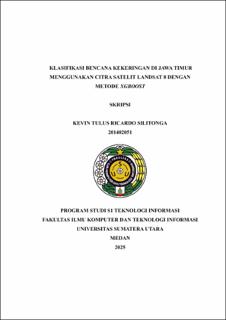Klasifikasi Bencana Kekeringan di Jawa Timur Menggunakan Citra Satelit Landsat 8 dengan Metode XGBoost
Classification of Drought Disaster in East Java Using Landsat 8 Satellite Imagery with the Xgboost Method

Date
2025Author
Silitonga, Kevin Tulus Ricardo
Advisor(s)
Purnamawati, Sarah
Jaya, Ivan
Metadata
Show full item recordAbstract
Drought disasters cause major impacts such as reduced clean water, damage to food
crops and the destruction of environmental ecosystems that occur in very large areas
for a very long time. In monitoring droughts today, it takes quite a long time. Usually
the time used in monitoring is carried out within a month. From the existing problems,
the need for drought information to the community and authorities is needed to reduce
losses by anticipating drought and mitigating the social, economic and environmental
impacts caused by drought disasters. So a system is needed that can classify drought
disasters quickly and accurately. This study uses the XGBoost algorithm, which has the
ability to handle spectral variability in satellite imagery data. The data used includes
Landsat 8 satellite imagery with Band 4, Band 5, and Band 10 for calculating the
vegetation index, as well as SPI and DEM data. The dataset consists of 168 raster
images from 2014 to 2022, which are then divided into 80% for training data and 20%
for testing data. The XGBoost model was trained and evaluated using the data to
classify images into five categories of drought severity: extreme drought, severe
drought, moderate drought, mild drought, and no drought. The results showed that the
XGBoost model achieved an overall accuracy of 89.40%. The high precision, recall,
and F1 score values for each class indicate the model's ability to identify various levels
of drought severity well.
Collections
- Undergraduate Theses [873]
